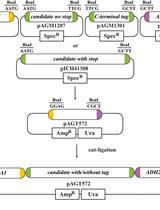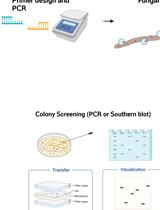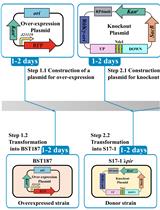- EN - English
- CN - 中文
Egg Microinjection for the Silkworm Bombyx mori
家蚕卵的显微注射操作方法
发布: 2025年05月20日第15卷第10期 DOI: 10.21769/BioProtoc.5317 浏览次数: 3169
评审: Olga KopachJesús Hernández Falcón
Abstract
The silkworm Bombyx mori has been extensively utilized in sericulture and serves as a representative model insect of Lepidoptera in various fields of life sciences and applied research. In recent years, its significance has further increased in molecular genetics and functional genomics. Germline transformation and genome editing in B. mori require the injection of vector solutions into early embryos; however, the thick eggshell of B. mori presents a significant challenge for microinjection. Conventional methods involve arranging eggs, pre-pierced with a tungsten needle, followed by solution injection, making the process both time-consuming and technically demanding. Here, we describe a simplified and more efficient microinjection protocol. Unlike conventional approaches, our method eliminates the need for egg removal from the egg-laying sheet and egg alignment on the slide glass by allowing injections to be performed directly on eggs retained on the egg-laying sheet. A thick-walled glass capillary, capable of penetrating the rigid eggshell, is used to directly pierce the eggshell and deliver the solution. By eliminating the need for egg alignment and micromanipulator operation, this protocol significantly enhances efficiency, enabling higher-throughput embryo injections within a shorter time frame. Moreover, this approach holds potential for application to other insect species with similarly thick eggshells.
Key features
• A simple and efficient microinjection method for silkworm eggs.
• Eliminates the need for egg alignment by injecting directly into eggs attached to the oviposition substrate.
• Conducted without a micromanipulator or tungsten needle to pierce the eggshell, using only a handheld thick-walled glass capillary.
• Applicable to other insect species with thick eggshells.
Keywords: Egg microinjection (卵显微注射)Background
The silkworm Bombyx mori is an important industrial insect widely used for silk production and as a platform for producing foreign proteins and pharmaceuticals [1]. It has also served as a key model organism for lepidopteran insects, contributing to fundamental research in genetics, physiology, biochemistry, developmental biology, and pathology [2–4]. In recent years, the complete sequencing and annotation of the silkworm genome [5,6], along with advances in genetic engineering [7], have further established B. mori as a valuable model for functional genomics research. Germline transformation and genome editing in silkworms require the injection of vector solutions into early embryos [8,9]. However, the thick eggshell of silkworms presents a significant challenge for microinjection [10].
A previous microinjection protocol for silkworm eggs was reported by Tamura et al. [10]. Their protocol consists of three steps: 1) removing the eggs from the egg-laying sheet and arranging them on a glass slide with their ventral sides aligned for injection; 2) pre-piercing the eggshell using a tungsten needle mounted on a micromanipulator; and 3) the glass capillary mounted on the micromanipulator is precisely positioned to be inserted through the hole made in the eggshell and used to inject the solution. Although this method is effective, it requires a specialized manipulator and involves time-consuming procedures such as aligning the eggs and adjusting the micromanipulator. Additionally, it demands a high level of technical skill, making the overall workload substantial.
In contrast, our protocol is simpler and more efficient by eliminating all three steps. Eggs remain on the egg-laying sheet as laid, and injection is performed directly without removal or alignment. A thick-walled glass capillary, capable of penetrating the thick eggshell, is held by hand to directly pierce the eggshell at the desired position and inject the solution. By eliminating the need to align eggs and operate a micromanipulator, our protocol significantly improves work efficiency, enabling injections into a larger number of eggs in less time. In particular, injection into early embryos must be performed within a limited time window during the syncytial blastoderm stage, before the cellular blastoderm forms. Therefore, the efficiency of this method is crucial. Moreover, since it does not require the use of a micromanipulator, the technical burden is reduced, making the technique more accessible to a broader range of researchers.
The microinjection method described in this protocol is not limited to silkworm eggs but can be broadly applied to other species with thick eggshells, such as the gypsy moth Lymantria dispar, the tea tussock moth Orgyia thyellina, the brown-winged green stink bug Plautia stali, and the bell cricket Meloimorpha japonica. By mitigating the technical challenges associated with microinjection, this approach has the potential to facilitate research in a wide range of fields, including functional genomics.
Materials and reagents
Biological materials
1. Bombyx mori eggs, larvae, pupae, and adults can be purchased from the National BioResource Project (NBRP) at Kyushu University; eggs are also available from the National Agriculture and Food Research Organization (NARO). When rearing from eggs or larvae, mulberry leaves (available from NBRP at Kyushu University) or artificial diet (available from Nosan Corporation) can be used as feed
Note: Since some silkworm strains are not suitable for rearing on artificial diets, it is recommended to check the feeding ability of artificial diets using the comprehensive silkworm resource database, Silkworm Base (https://shigen.nig.ac.jp/silkwormbase/about_kaiko.jsp).
Reagents
1. Fast Green FCF (Sigma-Aldrich, catalog number: F7252)
Note: This dye was used in Video 1 as a visual marker at a final concentration of 0.1% to demonstrate the injection process.
Laboratory supplies
1. Micro-loading tip (Eppendorf, catalog number: 5242 956 003)
2. Glass capillary (Daiwa Union, catalog number: uMPm-02)
Note: This glass capillary is a commercially available product suitable for silkworm egg microinjection. It does not require shaping with a puller. The capillary has an outer diameter of 1.5 mm, an inner diameter of 0.6 mm, and a tip outer diameter of approximately 35 μm, which we define as a “fine capillary tip” in this protocol.
3. Egg-laying sheet (Ehime-Sanshu, catalog number: 125)
4. Clear plastic cup (used for mating and oviposition) (Ai’ris, catalog number: 414-9650-727)
5. Insect rearing case (Sanplatec, catalog number: 02322)
6. Petri dish (Ina Optica, catalog number: I-90)
7. Paper towel (placed at the bottom of the rearing case)
8. Humid chamber
Equipment
1. FemtoJet 4i (Eppendorf, catalog number: 2229001215)
2. Microcentrifuge (TOMY, model: MX-307 or equivalent)
3. Foot pedal switch (Eppendorf, included with the FemtoJet 4i)
4. Capillary holder (Narishige, model: HI-7)
5. Grip head for capillary holder (Narishige, model: HIC-1.5)
Note: Although the FemtoJet 4i includes an Eppendorf capillary holder and grip head, we used the Narishige HI-7 capillary holder in this protocol. This holder, when combined with the HIC-1.5 grip head, provides a smoother and more stable grip due to the absence of a joint gap. While the combination of the Eppendorf holder and grip head is also compatible with the same glass capillaries, we found the Narishige setup easier to handle during handheld injection.
6. Pipetman [GILSON, catalog number: F123600 (P20)]
7. Stereomicroscope (Olympus, model: SZX16 or equivalent)
Procedure
文章信息
稿件历史记录
提交日期: Mar 20, 2025
接收日期: Apr 21, 2025
在线发布日期: May 5, 2025
出版日期: May 20, 2025
版权信息
© 2025 The Author(s); This is an open access article under the CC BY-NC license (https://creativecommons.org/licenses/by-nc/4.0/).
如何引用
Yamada, H., Yaginuma, T., Mase, K. and Niimi, T. (2025). Egg Microinjection for the Silkworm Bombyx mori. Bio-protocol 15(10): e5317. DOI: 10.21769/BioProtoc.5317.
分类
发育生物学 > 基因组编辑
分子生物学 > DNA > 转化
您对这篇实验方法有问题吗?
在此处发布您的问题,我们将邀请本文作者来回答。同时,我们会将您的问题发布到Bio-protocol Exchange,以便寻求社区成员的帮助。
Share
Bluesky
X
Copy link













